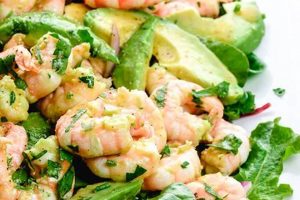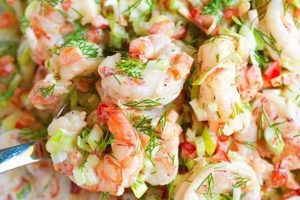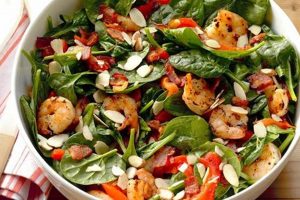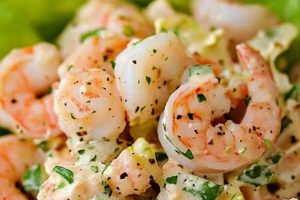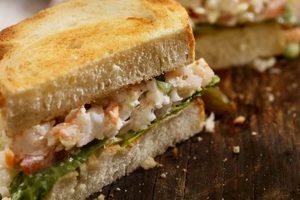A guide to preparing a chilled seafood dish featuring cooked shrimp, typically bound with mayonnaise and enhanced with the distinctive flavor profile of Old Bay Seasoning. This dish often includes additional ingredients such as celery, onion, and fresh herbs. Variations exist using different types of mayonnaise, incorporating lemon juice, or adding other vegetables for texture and flavor complexity. An example would be a preparation featuring cooked, chilled shrimp, mayonnaise, finely diced celery and red onion, Old Bay Seasoning, and a squeeze of lemon juice, served on lettuce cups or bread.
Chilled shrimp salad offers a refreshing and flavorful meal option, especially suitable for warm weather. The combination of succulent shrimp and the savory, slightly spicy blend of Old Bay creates a balanced and appealing taste. This dish can be prepared in advance, making it a convenient choice for gatherings or quick lunches. Historically, similar seafood salads have been enjoyed for centuries, evolving alongside culinary traditions and the availability of ingredients. The specific combination with Old Bay likely emerged more recently, reflecting the seasoning’s popularity in regions where it is commonly used.
The following sections will delve into specific variations on this culinary theme, providing detailed instructions, ingredient lists, nutritional information, and tips for achieving optimal results. Discussions will also cover appropriate serving suggestions, potential substitutions for dietary restrictions, and techniques for storing and preserving the finished product.
Tips for Shrimp Salad with Old Bay
Optimizing shrimp salad preparation ensures a flavorful and enjoyable culinary experience. Attention to detail, from ingredient selection to chilling time, contributes significantly to the dish’s overall quality. The following tips offer guidance for achieving excellent results.
Tip 1: Shrimp Selection and Preparation: Opt for high-quality, fresh or properly frozen shrimp. Thorough thawing and gentle cooking prevent rubbery texture. Overcooked shrimp results in a tough, less palatable salad.
Tip 2: Mayonnaise Considerations: Full-fat mayonnaise provides a richer, creamier texture. Reduced-fat options can be substituted, but may slightly alter the final consistency. Homemade mayonnaise allows complete control over ingredients and flavor profiles.
Tip 3: Old Bay Usage: Start with a moderate amount of Old Bay Seasoning and adjust to taste. Over-seasoning can easily overpower the delicate shrimp flavor.
Tip 4: Enhancing Flavor Complexity: Incorporating fresh herbs such as dill, chives, or parsley adds brightness and depth. A squeeze of lemon juice provides acidity, balancing the richness of the mayonnaise.
Tip 5: Texture Enhancement: Finely diced celery and red onion offer a satisfying crunch. Other vegetables, such as finely diced bell peppers or water chestnuts, can also contribute textural variety.
Tip 6: Chilling Time: Allowing the salad to chill for at least 30 minutes, and preferably longer, allows the flavors to meld and develop fully.
Tip 7: Serving Suggestions: Shrimp salad can be served in a variety of ways, including on lettuce cups, croissants, or crackers. It also makes an excellent filling for sandwiches or wraps.
By following these guidelines, one can consistently produce a superior shrimp salad, maximizing the inherent flavors of the ingredients and creating a dish that is both satisfying and refreshing.
Concluding remarks on preparing shrimp salad with Old Bay will now follow, offering a final overview of the essential elements discussed throughout this piece.
1. High-quality shrimp
High-quality shrimp plays a crucial role in a successful shrimp salad featuring Old Bay seasoning. The shrimp’s inherent flavor and texture significantly influence the final dish, impacting overall enjoyment. Subpar shrimp can result in a disappointing culinary experience, regardless of other ingredient quality or preparation techniques.
- Flavor Profile:
High-quality shrimp possesses a naturally sweet, delicate flavor that harmonizes well with the savory, slightly spicy notes of Old Bay. Fresh, properly handled shrimp exhibits a clean taste, free from off-flavors or iodine-like characteristics often associated with lower-quality product. This allows the nuanced flavors of the Old Bay and other ingredients to shine through. Conversely, strong, fishy-tasting shrimp can negatively impact the entire salad.
- Texture:
Shrimp quality directly correlates with texture. Superior shrimp, when cooked correctly, offers a firm, yet succulent bite. This desirable texture contrasts pleasantly with the creamy mayonnaise and any added vegetables, creating a balanced mouthfeel. Overcooked or poorly handled shrimp becomes tough and rubbery, detracting from the overall enjoyment.
- Visual Appeal:
High-quality shrimp typically exhibits a bright, translucent appearance with a firm, intact structure. This contributes to the salad’s aesthetic presentation. Discolored, mushy, or broken shrimp can create an unappetizing appearance, diminishing the appeal of the finished dish.
- Overall Culinary Experience:
Ultimately, the use of high-quality shrimp elevates the entire dining experience. The superior flavor, texture, and visual appeal combine to create a more satisfying and enjoyable salad. This attention to detail ensures that the inherent qualities of both the shrimp and the Old Bay seasoning are showcased effectively.
The selection of high-quality shrimp represents a fundamental step in preparing exceptional shrimp salad with Old Bay. Investing in superior shrimp significantly impacts the final dish, ensuring a flavorful, visually appealing, and texturally satisfying culinary result. Neglecting this aspect can compromise the overall quality, regardless of other efforts made during preparation.
2. Proper shrimp cooking
Proper shrimp cooking is paramount in achieving a high-quality shrimp salad featuring Old Bay seasoning. Overcooked shrimp becomes tough, rubbery, and loses its delicate sweetness, negatively affecting the salad’s overall texture and flavor profile. Undercooked shrimp presents food safety concerns and may exhibit an unappetizing, translucent texture. The goal is to achieve a tender, succulent texture that complements the other ingredients. Several methods, including poaching, steaming, and boiling, can achieve optimal results; however, each demands precise timing and temperature control. For instance, boiling requires rapidly plunging shrimp into boiling water and removing them promptly once they turn pink and opaque, typically within 2-3 minutes depending on size. This rapid cooking method helps retain moisture and prevents overcooking. Similarly, steaming offers gentle, even cooking, preserving the shrimp’s natural sweetness and delicate texture. Poaching, another gentle method, allows for precise temperature control and infusion of subtle flavors from the poaching liquid. The chosen cooking method should align with the desired outcome and available resources, but precision remains critical regardless of technique.
The impact of properly cooked shrimp extends beyond texture. Optimal cooking preserves the shrimp’s inherent flavor, allowing it to harmonize with the Old Bay seasoning and other ingredients. Overcooked shrimp loses its subtle sweetness, diminishing the complexity of the salad’s flavor profile. Conversely, undercooked shrimp may possess a raw, slightly metallic taste that clashes with the Old Bay’s savory notes. Achieving the ideal level of doneness ensures that the shrimp contributes its full flavor potential to the dish. Consider a shrimp salad featuring perfectly cooked, succulent shrimp. The delicate sweetness of the shrimp enhances the Old Bay’s warm, savory spices, creating a balanced and nuanced flavor profile. The tender texture of the shrimp contrasts pleasantly with the creamy mayonnaise and crunchy vegetables, creating a satisfying mouthfeel. Now, envision a salad made with overcooked shrimp. The tough, rubbery texture detracts from the overall enjoyment, and the diminished shrimp flavor fails to complement the Old Bay seasoning, resulting in a less satisfying dish. This comparison highlights the importance of proper shrimp cooking in achieving a balanced and flavorful shrimp salad.
Mastery of shrimp cooking techniques is essential for producing high-quality shrimp salad. Precise control over cooking time and temperature, regardless of the chosen method, ensures optimal texture and flavor. This attention to detail elevates the shrimp from a mere ingredient to a key component that harmonizes with the Old Bay seasoning and other elements, ultimately determining the salad’s overall success. Failure to execute this step correctly compromises the entire dish, underscoring the importance of proper shrimp cooking as a foundational element in any recipe for shrimp salad featuring Old Bay.
3. Balanced Old Bay Seasoning
Balanced Old Bay seasoning is crucial for a successful shrimp salad. The seasoning’s distinctive blend of herbs and spices can significantly enhance the shrimp’s flavor, but its potency requires careful application. Over-seasoning can easily overwhelm the delicate shrimp and other ingredients, while under-seasoning results in a bland, uninspired dish. Achieving the right balance maximizes the synergy between the Old Bay and other components, creating a harmonious flavor profile.
- Flavor Complexity:
Old Bay Seasoning contributes a complex flavor profile, encompassing celery salt, paprika, black pepper, red pepper flakes, and other spices. This complexity can elevate the shrimp salad beyond a simple seafood dish, adding depth and nuance. However, excessive Old Bay can mask the subtle sweetness of the shrimp and other delicate flavors. A balanced approach allows the individual components of the seasoning to complement the other ingredients without dominating the overall taste.
- Heat Level:
Old Bay contains spices like paprika and red pepper flakes that contribute varying levels of heat. The perceived spiciness can fluctuate based on individual palates and specific product formulations. Careful consideration of this heat level is essential for achieving a balanced flavor profile. Too much Old Bay can create an overly spicy salad, obscuring the other flavors. A measured approach ensures a pleasant warmth that enhances, rather than overwhelms, the shrimp and other components.
- Salt Content:
Old Bay Seasoning contains a significant amount of salt. This saltiness contributes to the overall flavor profile and helps to enhance the shrimp’s natural sweetness. However, over-seasoning can lead to an excessively salty salad. Awareness of this salt content is essential, especially when considering other salty ingredients that might be present in the recipe, such as mayonnaise or certain types of bread. A balanced approach allows the saltiness of the Old Bay to enhance the other flavors without making the salad unpalatably salty.
- Interaction with Other Ingredients:
The Old Bay seasoning interacts dynamically with the other ingredients in the shrimp salad. Its flavors meld with the mayonnaise, vegetables, and any additional herbs or spices. A balanced application allows these flavors to harmonize effectively. Too much Old Bay can disrupt this harmony, overpowering the subtle flavors of the other components. A measured approach ensures that the Old Bay enhances, rather than dominates, the overall flavor profile of the salad.
Balancing Old Bay seasoning is essential for creating a successful shrimp salad. Careful consideration of its complex flavor profile, heat level, salt content, and interaction with other ingredients allows the seasoning to enhance the dish without overwhelming it. The ultimate goal is to achieve a harmonious balance where the Old Bay complements the shrimp and other components, creating a delicious and well-rounded culinary experience. Failing to achieve this balance can compromise the entire dish, turning a potentially delightful salad into an unbalanced and less enjoyable meal.
4. Fresh Ingredients
Fresh ingredients are essential for a high-quality shrimp salad featuring Old Bay seasoning. Their vibrancy elevates the dish beyond a simple combination of cooked shrimp and mayonnaise, contributing significantly to the overall flavor, texture, and aroma. Freshness enhances the synergy between ingredients, allowing the nuanced flavors of the Old Bay to meld harmoniously with the other components. For instance, freshly squeezed lemon juice adds brightness and acidity, balancing the richness of the mayonnaise and enhancing the savory notes of the Old Bay. Similarly, freshly chopped herbs like dill or chives provide a vibrant, herbaceous counterpoint to the seafood and spice blend, creating a more complex and aromatic salad. Conversely, using wilted herbs or bottled lemon juice can result in a dull, less flavorful dish, diminishing the impact of the Old Bay seasoning. Consider the difference between a salad made with crisp, freshly diced celery and one using limp, pre-cut celery. The fresh celery provides a satisfying crunch and clean flavor, while the pre-cut celery may contribute a watery, less appealing texture and a muted taste. This comparison underscores the importance of ingredient freshness in achieving a balanced and flavorful outcome.
The impact of fresh ingredients extends beyond flavor and texture. They also contribute to the salad’s visual appeal, creating a more vibrant and appetizing presentation. Freshly chopped herbs provide a pop of color and texture, while brightly colored vegetables enhance the overall aesthetic. This visual element plays a significant role in the dining experience, influencing perceptions of flavor and enjoyment. Furthermore, using fresh, high-quality ingredients can minimize the need for excessive seasoning or additives. The natural flavors of the components shine through, allowing for a more nuanced and less processed taste. This aligns with culinary trends that emphasize clean eating and maximizing the inherent flavors of fresh produce. From a practical standpoint, sourcing fresh, seasonal ingredients often supports local farmers and reduces environmental impact compared to relying on processed or out-of-season produce. This consideration adds another layer of value to the emphasis on freshness in shrimp salad preparation.
In conclusion, the use of fresh ingredients is paramount in creating a truly exceptional shrimp salad with Old Bay seasoning. Their contribution extends beyond mere flavor enhancement, impacting texture, aroma, visual appeal, and even broader culinary values. Prioritizing fresh components allows the inherent qualities of the ingredients, including the distinctive character of the Old Bay, to shine through, resulting in a more vibrant, flavorful, and ultimately satisfying culinary experience. Substituting fresh ingredients with processed or less vibrant alternatives compromises the potential of the dish, underscoring the significance of freshness in achieving a balanced and delicious shrimp salad.
5. Appropriate Chilling Time
Appropriate chilling time is integral to a successful shrimp salad incorporating Old Bay seasoning. Chilling allows the flavors of the various componentsshrimp, Old Bay, mayonnaise, and other ingredientsto meld and mature, resulting in a more cohesive and balanced flavor profile. This process enhances the synergy between the Old Bay’s complex spice blend and the sweetness of the shrimp, while also allowing the flavors of any added vegetables or herbs to integrate fully. Insufficient chilling can result in a disjointed flavor experience, where individual ingredients stand out rather than harmonizing into a unified whole. Conversely, excessive chilling, while not detrimental to safety in most cases, can dull certain flavors and affect the texture of more delicate components. For example, chilling a shrimp salad containing finely diced herbs for an extended period can cause the herbs to lose their vibrancy and contribute a less appealing texture. Ideally, a chilling period of at least 30 minutes, and preferably 1-2 hours, allows the flavors to meld without compromising the integrity of individual ingredients.
The benefits of appropriate chilling extend beyond flavor development. Chilling also firms the texture of the shrimp, enhancing the salad’s overall mouthfeel. This is particularly beneficial when using smaller shrimp that might otherwise become mushy or lose their shape during mixing and serving. Additionally, chilling allows the mayonnaise to set and stabilize, preventing the salad from becoming watery or separating. This improved consistency facilitates cleaner serving and enhances the visual appeal of the finished dish. Consider a shrimp salad prepared without sufficient chilling time. The flavors may be underdeveloped, with the Old Bay, shrimp, and other ingredients tasting distinct rather than integrated. The texture may be less firm, and the mayonnaise could be loose, resulting in a less appealing presentation. In contrast, a properly chilled salad showcases a harmonious blend of flavors, a firm yet succulent texture, and a visually appealing consistency.
In summary, appropriate chilling time is a crucial step in preparing shrimp salad with Old Bay seasoning. It facilitates flavor development, improves texture, and enhances presentation. Understanding the impact of chilling time allows for a more deliberate and successful approach to shrimp salad preparation, maximizing the dish’s overall quality and enjoyment. Neglecting this step, while seemingly minor, can significantly compromise the final product, highlighting the critical role of chilling time in achieving a balanced and flavorful outcome. This principle also applies to other dishes utilizing a blend of ingredients and seasonings, emphasizing the importance of considering chilling time as an essential element in recipe development and execution.
6. Complementary Serving Choices
Complementary serving choices significantly enhance the enjoyment of shrimp salad prepared with Old Bay seasoning. Serving choices provide textural contrast and flavor balance, transforming the salad from a simple dish into a more complex and satisfying culinary experience. Consideration of these choices demonstrates an understanding of how different textures and flavors interact, elevating the overall perception of the dish. For example, serving shrimp salad on a buttery, flaky croissant creates a textural interplay between the creamy salad and the crisp, layered pastry. The richness of the croissant complements the savory Old Bay seasoning, while the flakiness prevents the salad from becoming overly rich. Conversely, serving the same salad on soft white bread might result in a texturally monotonous experience, where the softness of the bread fails to contrast with the creamy salad. The bread’s neutral flavor may also be insufficient to balance the richness of the mayonnaise and the spiciness of the Old Bay. Selecting appropriate serving vessels demonstrates an awareness of these textural and flavor dynamics.
Several factors influence the suitability of a serving choice. The salad’s texture, influenced by the size and type of shrimp, the amount of mayonnaise, and the presence of additional ingredients like celery or onion, dictates compatible serving options. A chunkier salad, with larger shrimp and a higher proportion of diced vegetables, might pair well with sturdy crackers or crisp lettuce cups. A finer salad, with smaller shrimp and a smoother consistency, might benefit from a softer vessel like a croissant or a small, crusty roll. The intensity of the Old Bay seasoning also plays a role. A more heavily seasoned salad might require a serving choice with a bolder flavor or texture to balance the spice, while a lightly seasoned salad might pair well with a more delicate option. Real-life examples abound. Shrimp salad served atop crisp endive leaves offers a refreshing contrast between the creamy salad and the slightly bitter greens. Serving the salad as a filling in a toasted baguette provides a substantial, texturally satisfying meal. Each serving choice alters the dining experience, impacting both perception and enjoyment.
Understanding the impact of serving choices allows for a more nuanced and considered approach to enjoying shrimp salad with Old Bay. It highlights the importance of thinking beyond the salad itself and considering how it interacts with other elements of the meal. Practical applications include tailoring serving choices to specific occasions or preferences. For a light lunch, serving the salad on crisp lettuce cups emphasizes freshness and minimizes heaviness. For a more substantial meal, a toasted baguette or a hearty roll provides a more filling base. Successfully navigating these choices elevates the dining experience, transforming a simple shrimp salad into a carefully considered and thoroughly enjoyable culinary creation. This principle of complementary elements extends to other dishes and cuisines, demonstrating the broader significance of understanding how different flavors and textures interact to create a balanced and satisfying meal.
7. Considerate Ingredient Proportions
Considerate ingredient proportions are essential for a well-balanced and flavorful shrimp salad featuring Old Bay seasoning. Proportions directly influence the final dish’s taste, texture, and overall appeal. Careful balancing ensures that no single ingredient dominates, allowing the nuanced flavors of the shrimp, Old Bay, and other components to harmonize effectively. This careful approach transforms the salad from a mere collection of ingredients into a cohesive culinary creation. Ingredient proportions affect the overall balance between key flavor profiles: the sweetness of the shrimp, the savory spice of the Old Bay, the richness of the mayonnaise, the acidity of any added lemon juice, and the textures of additional vegetables. An excess of mayonnaise, for example, can mask the delicate flavors of the shrimp and Old Bay, resulting in a bland, overly rich salad. Conversely, too little mayonnaise can create a dry, less palatable texture. Similarly, an overabundance of celery can overwhelm the other ingredients, shifting the textural balance from creamy to crunchy and potentially overpowering the more subtle flavors. Consider a shrimp salad where the Old Bay seasoning is disproportionately high. The intense spice blend might overpower the delicate shrimp flavor, creating a salad that is more about spice than seafood. Conversely, insufficient Old Bay might leave the salad tasting bland and lacking the characteristic depth this seasoning provides.
Real-life examples illustrate the practical implications. A shrimp salad with a high ratio of shrimp to other ingredients offers a more pronounced seafood flavor and a lighter texture. A salad with a greater proportion of mayonnaise and finely diced vegetables delivers a richer, creamier experience. Recipes specifying precise measurements aim to guide these proportional considerations, ensuring consistent and predictable results. However, adaptation based on personal preference remains important. Some might prefer a more pronounced Old Bay flavor, while others prioritize the sweetness of the shrimp. Understanding the interplay of ingredients allows for informed adjustments to achieve desired outcomes. Consider the scenario of preparing shrimp salad for a gathering. Knowing the preferences of the guestssome might appreciate a spicier salad, while others might prefer a milder versionallows for adjustments to the Old Bay quantity. Similarly, understanding the impact of mayonnaise quantity enables adjustment based on desired creaminess versus a lighter, less rich texture.
Mastery of ingredient proportions elevates shrimp salad preparation from a simple assembly process to a culinary art. It empowers informed decision-making, allowing cooks to tailor the dish to specific preferences and desired outcomes. This understanding is crucial for consistent success, ensuring a balanced and flavorful shrimp salad that showcases the harmonious interplay of shrimp, Old Bay seasoning, and other complementary components. This principle extends beyond shrimp salad, applying broadly to culinary endeavors where balanced proportions contribute significantly to the final product’s success.
Frequently Asked Questions
This section addresses common inquiries regarding the preparation and enjoyment of shrimp salad seasoned with Old Bay.
Question 1: What type of shrimp is best suited for this salad?
While various shrimp species can be utilized, smaller varieties, such as pink or bay shrimp, offer a delicate sweetness and tender texture well-suited to cold salad preparations. Larger shrimp, like jumbo or tiger prawns, can also be incorporated but may require chopping to achieve a desirable texture.
Question 2: Can pre-cooked shrimp be used?
Pre-cooked shrimp offers convenience; however, freshly cooked shrimp generally yields superior flavor and texture. If pre-cooked shrimp is chosen, ensure it is high-quality and has been stored properly to maintain freshness.
Question 3: How can the salad’s spiciness be adjusted?
Old Bay Seasoning’s spiciness can be modulated by adjusting the quantity used. Start with a smaller amount and incrementally increase until the desired level of heat is achieved. Additional red pepper flakes can be incorporated for increased spiciness.
Question 4: What are suitable alternatives to mayonnaise?
Plain Greek yogurt or a mixture of Greek yogurt and mayonnaise can be substituted for a lighter, tangier flavor profile. Avocado can also be incorporated to create a creamy, healthier alternative.
Question 5: How long can shrimp salad be stored safely?
Properly stored in an airtight container in the refrigerator, shrimp salad typically remains safe for consumption for 3-4 days. Beyond this timeframe, quality and safety may deteriorate.
Question 6: Can this salad be frozen?
Freezing is not generally recommended. Freezing can negatively impact the mayonnaise’s texture, causing it to separate and become watery upon thawing. The texture of the shrimp and other ingredients may also be affected.
Careful consideration of these frequently asked questions facilitates successful preparation and enjoyment of shrimp salad seasoned with Old Bay.
Additional culinary insights and variations on this recipe will be explored in the following sections.
Conclusion
Exploration of this classic dish reveals the importance of quality ingredients, precise techniques, and balanced flavors. From shrimp selection and cooking methods to the judicious use of Old Bay seasoning and complementary ingredient pairings, each step contributes significantly to the final product. Proper chilling allows flavors to meld, while thoughtful serving choices elevate the overall dining experience. Consideration of ingredient proportions ensures a harmonious balance, preventing any single element from dominating the final flavor profile.
Culinary traditions evolve through experimentation and refinement. This exploration serves as a foundation, encouraging further exploration of flavor profiles and ingredient combinations. Adaptability and a willingness to experiment within established frameworks offer pathways to personalized culinary expression, ensuring that this classic dish continues to evolve and delight palates for generations to come.

